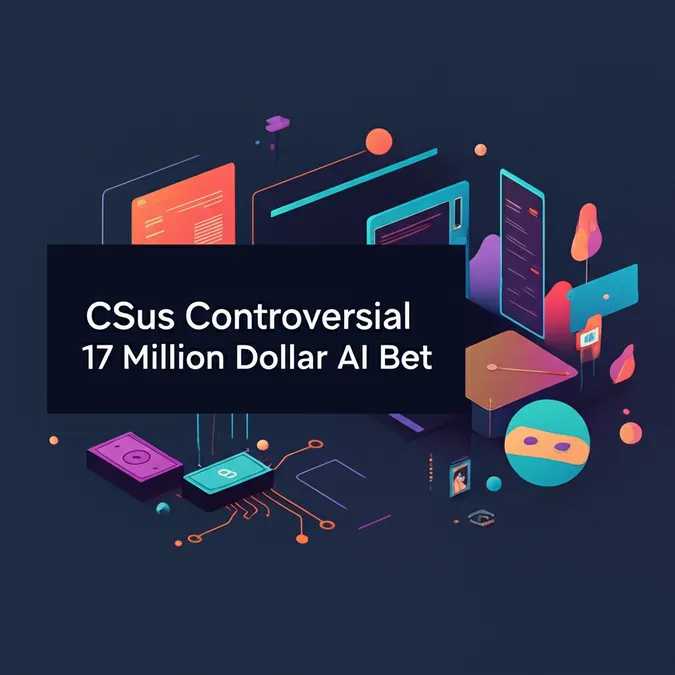Developer Offer
Try ImaginePro API with 50 Free Credits
Build and ship AI-powered visuals with Midjourney, Flux, and more — free credits refresh every month.
Who is Responsible for Enterprise AI Mistakes
The Shifting Sands of AI Accountability
A 1979 IBM training manual once declared, 'A computer can never be held accountable. Therefore, a computer must never make a management decision.' Fast forward to today, and the landscape has dramatically changed. In an age dominated by AI, that clear-cut stance has become much more ambiguous.
A recent IBM blog post acknowledges that AI will 'almost certainly' be used for some management decisions, citing its power to streamline operations and cut costs. However, it also concedes a critical point: 'What's less clear is how the shift to management-level decision-making will impact accountability.'
This shift from clarity to obfuscation is concerning. Where a firm line once existed, we now see backpedaling, especially when there are products like IBM's watsonx AI assistant to sell. The company's advice to focus on ethics, risk, and trust offers little concrete guidance, especially when AI itself doesn't comprehend ethics—a sentiment echoed by many human professionals as well.
Adding to the confusion, IBM's 2024 AI in Action report presents a familiar narrative of 'AI Leaders' (15%) and 'AI Learners' (85%). This is a classic marketing trope designed to create urgency and push product sales rather than providing genuine insight into the accountability crisis.
The Rise of Shadow AI in the Enterprise
More revealing insights come from a ManageEngine report, which highlights a significant trend: a large portion of 'enterprise AI' is actually 'shadow AI.' This means employees are using unsanctioned AI tools without any oversight from management, IT, or security.
The study, titled 'The Shadow AI Surge in Enterprises', surveyed professionals in large and mid-sized organizations across the US and Canada. The findings are staggering: 70% of respondents confirmed the use of unsanctioned AI tools in their workplace. This bottom-up adoption of tools like ChatGPT turns the traditional top-down technology implementation model on its head, creating a massive accountability problem.
The report indicates that this issue is growing, with 61% of businesses seeing an increase in shadow AI usage. A concerning 85% of decision-makers admit that staff are adopting AI tools faster than their IT teams can properly vet them.
Why Employees Use Unsanctioned AI and The Risks
So what are employees using these tools for? Primarily for tasks like summarizing meeting notes (56%) and brainstorming content (55%). This is alarming given the known issues with AI models misreporting facts, missing context, and even inventing information. For example, some AI summarization tools have been found to attribute fabricated data to named speakers, effectively rewriting history.
If even experienced lawyers have been caught presenting fake, AI-generated case law in court, what chance do other professionals have of spotting sophisticated AI hallucinations? With 47% of employees using shadow AI to analyze data and draft documents, the potential for introducing bogus information into the business is immense.
The reasons for this behavior are a mix of peer pressure ('everyone else is doing it,' 24%) and a lack of awareness. Many believe their actions are low-risk (36%) or that using a personal device makes it acceptable (42%). This collective blind spot leads to significant risks, with data leakage being the top concern for IT leaders. According to ManageEngine, one in three employees using shadow AI uploads sensitive company information to these tools, leading to potential IP infringement and copyright issues.
Pinpointing the Blame Where Does Accountability Lie
The ultimate, unaddressed question remains: who is accountable when something goes wrong? While managers might blame individual employees for errors or data breaches, regulators will hold the CEO or another senior officer responsible. The excuse 'it's the AI's fault' will not hold up.
AI vendors like OpenAI are unlikely to accept responsibility, often deflecting blame towards the vast, unvetted training data scraped from the web. This leaves organizations in a precarious position. As we become increasingly reliant on AI-generated information—with 60% of Google searches now being zero-click—it is crucial for businesses to anchor themselves to verifiable data sources outside of AI systems. The simple rule should be: don't trust what you can't independently verify.
The Next Frontier The Agentic AI Challenge
The accountability problem is set to become even more complex with the rise of agentic AI. Research from Okta reveals that 91% of organizations are already deploying AI agents, yet only 10% have the necessary identity management protocols in place. This is equivalent to putting unverified 'digital hires' to work with company data, a massive security risk when 80% of cyberattacks already involve compromised credentials.
Ultimately, the buck will stop with senior management. The critical challenge for leaders is to ensure their entire organization understands the risks associated with unsanctioned AI and to establish clear lines of responsibility before a costly mistake occurs.
Compare Plans & Pricing
Find the plan that matches your workload and unlock full access to ImaginePro.
| Plan | Price | Highlights |
|---|---|---|
| Standard | $8 / month |
|
| Premium | $20 / month |
|
Need custom terms? Talk to us to tailor credits, rate limits, or deployment options.
View All Pricing Details

